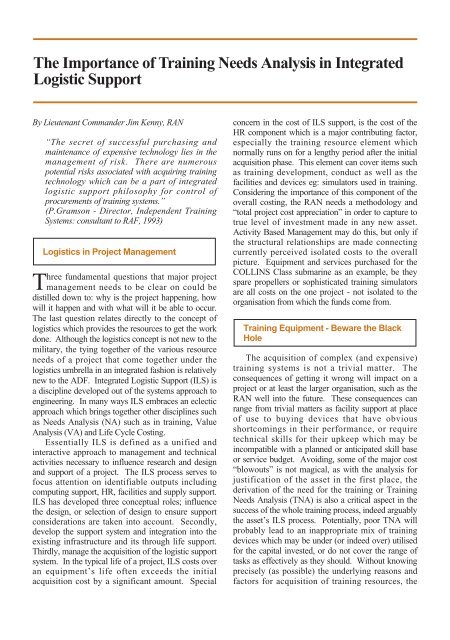ISSUE 136 : May/Jun - 1999 - Australian Defence Force Journal
ISSUE 136 : May/Jun - 1999 - Australian Defence Force Journal
ISSUE 136 : May/Jun - 1999 - Australian Defence Force Journal
- No tags were found...
You also want an ePaper? Increase the reach of your titles
YUMPU automatically turns print PDFs into web optimized ePapers that Google loves.
The Importance of Training Needs Analysis in IntegratedLogistic SupportBy Lieutenant Commander Jim Kenny, RAN“The secret of successful purchasing andmaintenance of expensive technology lies in themanagement of risk. There are numerouspotential risks associated with acquiring trainingtechnology which can be a part of integratedlogistic support philosophy for control ofprocurements of training systems.”(P.Gramson - Director, Independent TrainingSystems: consultant to RAF, 1993)Logistics in Project ManagementThree fundamental questions that major projectmanagement needs to be clear on could bedistilled down to: why is the project happening, howwill it happen and with what will it be able to occur.The last question relates directly to the concept oflogistics which provides the resources to get the workdone. Although the logistics concept is not new to themilitary, the tying together of the various resourceneeds of a project that come together under thelogistics umbrella in an integrated fashion is relativelynew to the ADF. Integrated Logistic Support (ILS) isa discipline developed out of the systems approach toengineering. In many ways ILS embraces an eclecticapproach which brings together other disciplines suchas Needs Analysis (NA) such as in training, ValueAnalysis (VA) and Life Cycle Costing.Essentially ILS is defined as a unified andinteractive approach to management and technicalactivities necessary to influence research and designand support of a project. The ILS process serves tofocus attention on identifiable outputs includingcomputing support, HR, facilities and supply support.ILS has developed three conceptual roles; influencethe design, or selection of design to ensure supportconsiderations are taken into account. Secondly,develop the support system and integration into theexisting infrastructure and its through life support.Thirdly, manage the acquisition of the logistic supportsystem. In the typical life of a project, ILS costs overan equipment’s life often exceeds the initialacquisition cost by a significant amount. Specialconcern in the cost of ILS support, is the cost of theHR component which is a major contributing factor,especially the training resource element whichnormally runs on for a lengthy period after the initialacquisition phase. This element can cover items suchas training development, conduct as well as thefacilities and devices eg: simulators used in training.Considering the importance of this component of theoverall costing, the RAN needs a methodology and“total project cost appreciation” in order to capture totrue level of investment made in any new asset.Activity Based Management may do this, but only ifthe structural relationships are made connectingcurrently perceived isolated costs to the overallpicture. Equipment and services purchased for theCOLLINS Class submarine as an example, be theyspare propellers or sophisticated training simulatorsare all costs on the one project - not isolated to theorganisation from which the funds come from.Training Equipment - Beware the BlackHoleThe acquisition of complex (and expensive)training systems is not a trivial matter. Theconsequences of getting it wrong will impact on aproject or at least the larger organisation, such as theRAN well into the future. These consequences canrange from trivial matters as facility support at placeof use to buying devices that have obviousshortcomings in their performance, or requiretechnical skills for their upkeep which may beincompatible with a planned or anticipated skill baseor service budget. Avoiding, some of the major cost“blowouts” is not magical, as with the analysis forjustification of the asset in the first place, thederivation of the need for the training or TrainingNeeds Analysis (TNA) is also a critical aspect in thesuccess of the whole training process, indeed arguablythe asset’s ILS process. Potentially, poor TNA willprobably lead to an inappropriate mix of trainingdevices which may be under (or indeed over) utilisedfor the capital invested, or do not cover the range oftasks as effectively as they should. Without knowingprecisely (as possible) the underlying reasons andfactors for acquisition of training resources, the

















